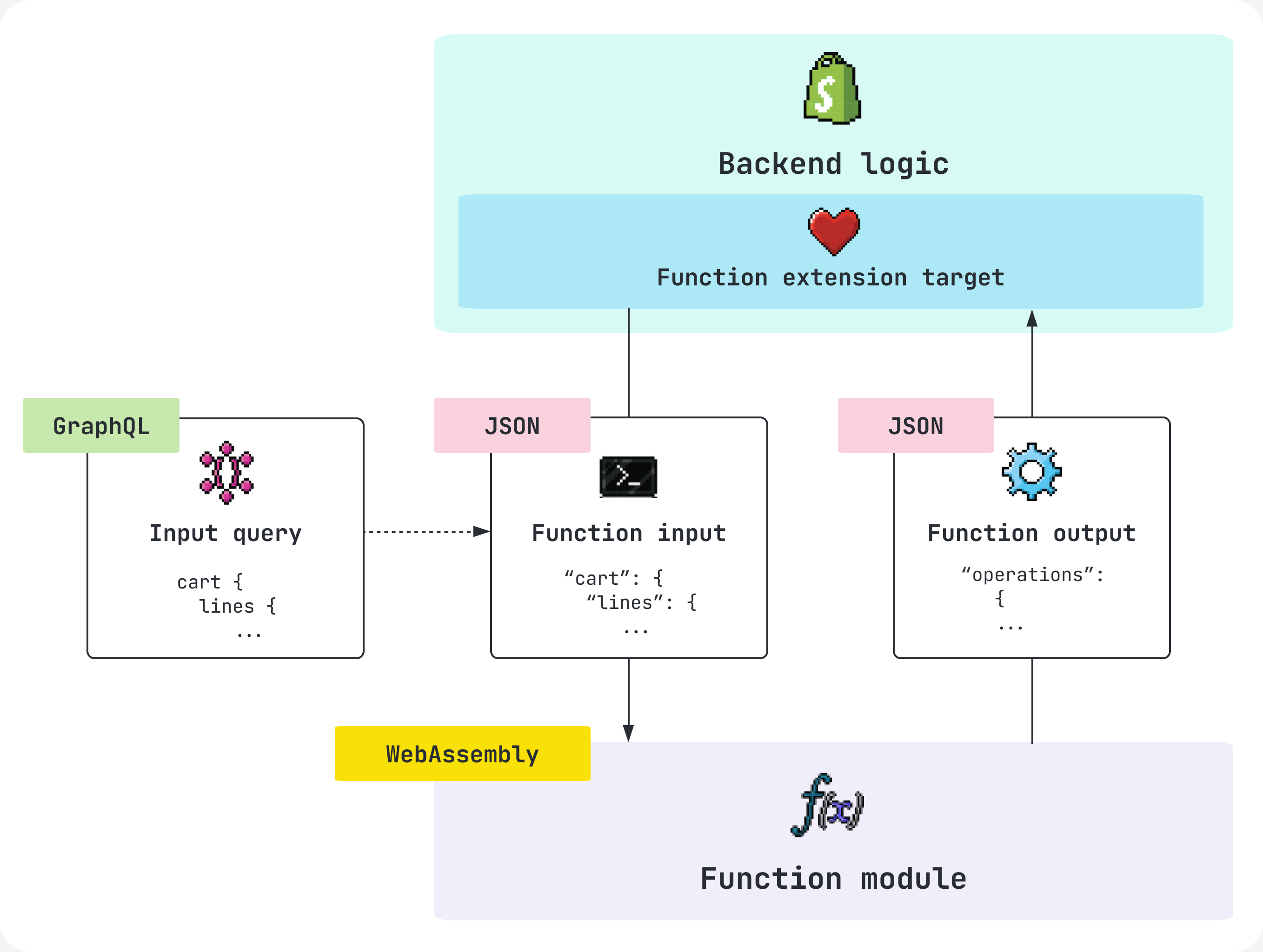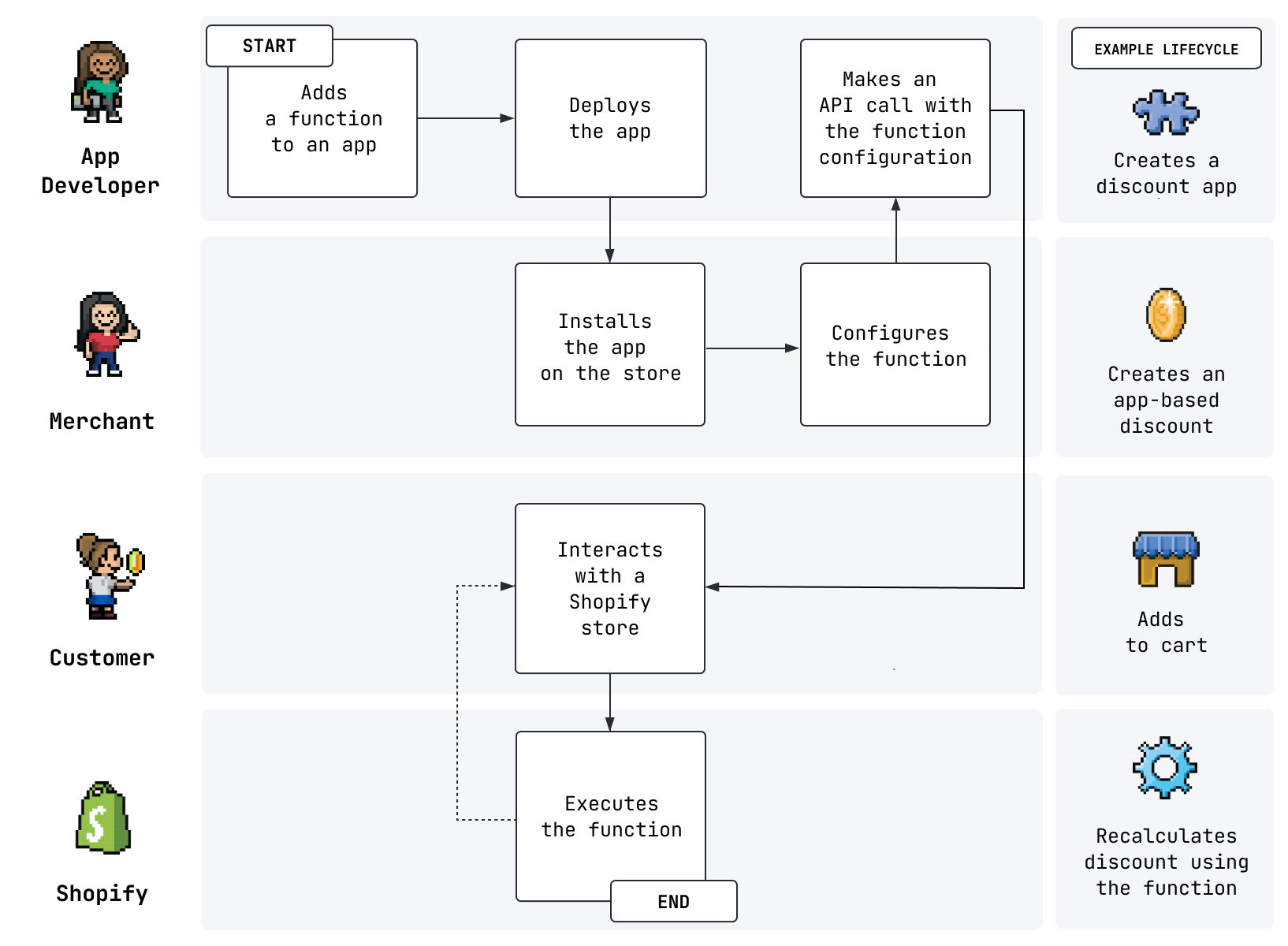Shopify Functions overview
Shopify Functions allow developers to customize the backend logic of Shopify. This guide introduces how Shopify Functions work and the benefits of using Shopify Functions.
How Shopify Functions work
Anchor link to section titled "How Shopify Functions work"Function extension targets inject code into the backend logic of Shopify. The following diagram shows how Shopify invokes a function which has been configured for an extension target:

- Function input: The function input is a JSON object which is the result of a GraphQL input query you define. Input queries allow you to select the specific data you need for your function, such as cart line product data or metafields.
- Function logic: The function logic is written in any language that can compile a WebAssembly module which meets function requirements. Function templates and client libraries are available for JavaScript and Rust.
- Function output: The function output is a JSON document that describes the operations you'd like Shopify to carry out.
GraphQL schemas provided by Shopify specify the targets, available inputs, and expected outputs for a Functions API.
Lifecycle of a Shopify Function
Anchor link to section titled "Lifecycle of a Shopify Function"The following diagram shows an example lifecycle of a Shopify Function:
App developers create and deploy apps that contain functions.
Merchants install the app on their Shopify store and configure the function. An API call is made with the function configuration.
Customers interact with a Shopify store and Shopify executes the function.
For example, an app developer might create and deploy an app with a function that defines a new discount type. The merchant can then install the app on their Shopify store and create a new discount from a discount type provided by the app. Shopify executes the function to calculate the discount when a customer adds a product to their cart.
Shopify Functions are never invoked directly by URL or otherwise. Shopify invokes them as-needed within the customer journey.

Getting started
Anchor link to section titled "Getting started"Learn how to use Shopify Functions by following one of our use case tutorials:
Developer tools and resources
Anchor link to section titled "Developer tools and resources"Explore the developer tools and resources available for Shopify Functions.
API versions
Anchor link to section titled "API versions"Function APIs are versioned. Updates are released quarterly and supported API versions are listed in the release notes.
Limitations and considerations
Anchor link to section titled "Limitations and considerations"The following limitations and considerations apply to all functions:
- Apps can reference only their own functions in GraphQL Admin API mutations, such as
discountAutomaticAppCreateandcartTransformCreate. Referencing a function from another app results in aFunction not founderror. - Shopify doesn't allow nondeterminism in functions, which means that you can't use any randomizing or clock functionality in your functions.
- The compiled function can't exceed 256 kB in size.
- You can't debug your function by printing out
STDOUT, which is reserved for function output. UseSTDERRinstead. Function logs to
STDERRare truncated after 1 kB. Some Wasm toolchains might crash ifSTDERRfails to write full logs.The logic of the function must execute in a maximum of 11 million instructions, which can be tested locally using
function-runner.At runtime, a function can't exceed the following memory limits:
- Linear memory limit: 10 MB
- Stack memory limit: 512 kB
A function's input cannot exceed 64,000 bytes in size.
Refer to input query limitations for more information.
A function's output can't exceed 20 kB in size.
An app can deploy a maximum of 100 functions.
Apps that provide dynamic editing and execution of function code aren't permitted on the Shopify App Store.
Network access is supported for some functions, refer to network access for more information. You can also pre-populate data by using metafields on products and customers, or passing data using cart attributes.
Deleting functions
Anchor link to section titled "Deleting functions"To delete a Shopify Function, you need to remove the relevant files from your app's /extensions directory, and then redeploy your app. Learn more about removing a Shopify Function.
When you delete a function, the following behavior occurs:
- The function, including all associated function owners, is permanently deleted.
- The function no longer runs, and becomes inaccessible to any Shopify stores that have your app installed.
- Learn about how data is input to and output from Shopify Functions.
- Explore the references for each Function API.